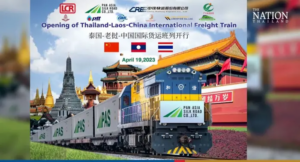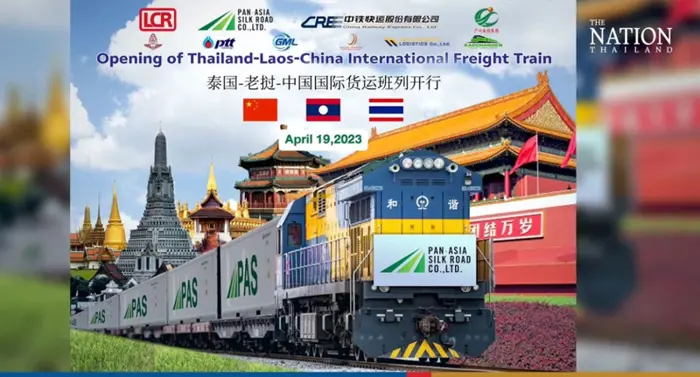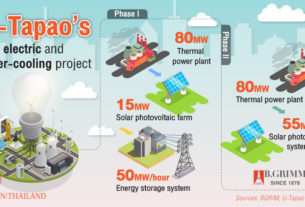
An Asean Silk Road on rails is taking shape
21 July 2024
THAILAND is marking the 130th anniversary of rail services in the kingdom with a bang: There is now a direct train service from Bangkok to the Laos capital of Vientiane, a distance of nearly 700km.
The inaugural express train pulled out of Bangkok’s Krung Thep Aphiwat Central Terminal Station (formerly known as the Bang Sue Grand Station) at 9pm yesterday, and as you are reading this, most probably has reached the brand new Khamsavath train station in Laos that opened on Oct 31 last year. The station is just a few kilometres from the Lao-Thai border that is marked by the Mekong River,
This is a fitting moment for rail development in Asean as Thai-land’s first railway line, the now defunct Paknam Railway opened for service in 1894 after three years of construction.
The Bangkok-Vientiane Express train utilises the single-track metre gauge line as it crosses the Thai-Lao Friendship Bridge over the Mekong River, before entering Lao territory by passing the Thanaleng station, and then terminating at Khamsavath station, a further 9km away.
This exciting development follows news of Thailand’s aim to upgrade its rail network, including its proposal to construct five separate high-speed rail (HSR) lines radiating out of Bangkok, including to the southern city of Hatyai.
The maiden Bangkok-Vientiane Express isn’t as speedy, though: Trundling across north-east Thailand on its way to Vientiane from Bangkok takes over 12 hours – not exactly HSR but great for people wanting to enjoy the landscape and journey.
Thailand bets on railLike Malaysia, Thailand is banking heavily of rail as a means to spur regional and national development.
In his first policy speech, new Thai Premier Srettha Thavisin said in March that Thailand will strive to build itself into a regional hub in eight important industries under the development agenda dubbed Thailand Vision 2030, also known as Ignite Thailand.
Srettha said the government wants to transform Thailand into a hub in tourism, wellness and medical services, agriculture and food, aviation, logistics, and mobility by capitalising on its natural resources, climate, and infrastructure expansion.
On becoming a logistic hub, Thailand plans to upgrade road, rail, and aviation-related infrastructure to enhance connectivity and facilitate the movements of goods and people, both domestically and internationally.
In February, the Bangkok Post reported that the board of the State Railway of Thailand (SRT) has given the green light to a plan to upgrade three routes to be double-tracked to increase capacity over lengths amounting to 634km with a combined investment of 113.14bil baht (RM14.5bil).
SRT governor Nirut Maneepan said the proposal for the three routes, which are part of the second phase of the double-track rail network, would be forwarded to the Thai Transport Ministry before Cabinet approval is sought.
They comprise the 281km Pak Nam Pho-Denchai route, the 308km Jira Junction-Ubon Ratchathani route, and the 45km Hat Yai-Padang Besar (in Perlis) route (costing some 7.9bil baht or nearly RM1bil), with the projects ready to start as soon as Cabinet approval is received.
The Pak Nam Pho-Denchai route comprises a 235km ground level section, a 40km elevated section and a 5.22km tunnel with 36 stations and three container yards. The Jira Junction-Ubon Ratchathani route comprises a 292.6km ground level section and three elevated sections covering 15km with a total of 35 stations. Overpasses, underpasses and wildlife crossings will also be built to alleviate impacts on local communities.
The Hat Yai-Padang Besar route includes a 44.5km ground level section with two elevated sections measuring 4.6km, three stations; this section involves land acquisition of nearly 3.4ha.
Meanwhile, the second phase comprises seven routes, and it involves the stretch that is headed towards Bangkok from Hat Yai, another development that will allow faster travel towards Bangkok and Laos from Malaysia.
The first of these – the 167km Khon Kaen-Nong Khai route (29.74bil baht or RM3.8bil) – has already been approved by the Thai Cabinet, with the terms of reference likely to have been completed by now.
The remaining projects worth 149.59bil baht (RM19.2bil) include the 168km Chumphon-Surat Thani route, the 189km Denchai-Chiang Mai route, and crucially, the 324km stretch from Hat Yai to Surat Thani, thus potentially speeding up the movements from Padang Besar to Bangkok, especially for Malaysian cargo trains.
High speed plans
It is important to note that Thailand is currently in the midst of building its own HSR line to connect Bangkok with Vientiane that uses the more universal “standard gauge”, or railway tracks that measure 1,435mm apart.
For example, KTM Bhd and most of the network operated by the SRT are still running on metre-gauge (1,000mm between rails), thus making it necessary to physically transfer containers at the Thanaleng and Vientiane South freight stations – both in Laos – to allow containers to/from China to continue their journey to Thailand or Malaysia, and vice versa.
Despite delays and high costs, Thailand remains committed towards the completion of its portion of the high-speed rail (HSR) from Bangkok to Vientiane, which is designed to offer speeds of around 250kph.
As mentioned earlier, the current direct services on a single track using metre gauge between Bangkok and Vientiane still needs close to 12 hours to complete, including customs and immigration formalities.
When the standard gauge (and likely double-tracked) HSR is completed, the same journey could be completed by around five hours.
As it stands, the Bangkok to Nakhon Ratchasima HSR stretch measuring 250km is currently under construction under Phase 1 of the north-eastern HSR line.
Phase 2 of the line, measuring 356km, will connect Nakhon Ratchasima with Nong Khai, the Thai town at the border with Laos, so that the train can be connected to the Lao-China railway, a three-year-old standard gauge line that goes all the way to Kunming in China and beyond.
The Thai Transport Ministry is now working on the proposal that will be submitted to the Cabinet for approval, with the submission expected to take place before September.
In a Facebook post, Ekarat Sriarayanphong, chief of the SRT Governor’s Office, said according to Surapong Piyachote, the deputy Transport Minister, there is a policy for the SRT to collaborate with the Lao National Railway State Enterprise to facilitate movements of passengers and freight between the two countries.
Ekarat also said train services between Thailand and Laos will help elevate Thailand’s logistics system to become a regional centre, in accordance with the Ignite Thailand outlook.
Outlook for Malaysia
According to transport consultant Goh Bok Yen, managing director of MAG Technical & Development Consultants Sdn Bhd, the trend is for countries – especially developed countries – to have more rail lines, with some supplanting flights.
“There is a need to provide backup and some measure of redundancy as rail transport such as in Japan, South Korea, China, and Europe. Rail is increasingly important to mitigate climate change as it remains the most efficient form of travel when measured on a per capita or per km emissions basis,” he said when contacted.
“It looks like Thailand is serious about the smooth movement of people and goods, when we look at their plans, including for HSR,” he added.
Just this week, Transport Minister Anthony Loke said the government will wait until December to decide on whether Malaysian’s HSR project will proceed, and the form it will take should it go ahead.
Datuk Mohd Nur Ismal Mohamed Kamal, CEO of MyHSR Corp Sdn Bhd, the special purpose vehicle set up by the Malaysian government to oversee the Kuala Lumpur to Singapore HSR, said there is a pressing need to facilitate the movement of people between the two cities using a line dedicated to passengers as time in itself is an extremely precious commodity.
“There is a huge potential to be tapped in the movement of people between Kuala Lumpur and Singapore, and having a properly configured HSR system will allow the creation of a conurbation that serves to produce win-win outcomes for both countries,” he said when contacted.
“People should refrain from framing the KL-Singapore HSR as one that will provide more benefits to Singapore.
“Malaysia has so much to gain from this project, and we are not talking just about climate mitigation and the provision of jobs both during and after the project. Just like Thailand, this transformative project has everything needed to ‘Ignite Malaysia’,” he said.
Source: https://www.thestar.com.my/news/focus/2024/07/21/an-asean-silk-road-on-rails-is-taking-shape



